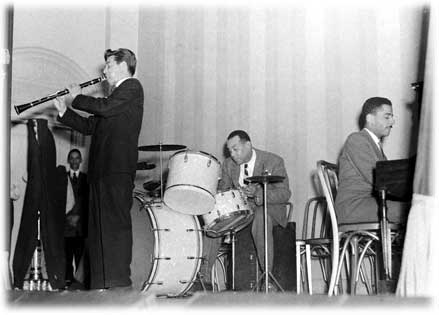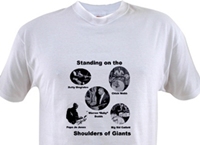Anyone who posts an opinion in a blog or forum is, by definition, a critic. The better informed, the better the quality of the critical analysis or commentary. While Jazz: A Film by Ken Burns will give you a reasonable background, what you are getting is a summary of Jazz according to Wynton [Marsalis] and Stanley [Crouch], and all of the bias they bring to it. If you are aware of the bias, the 10-DVD set is valuable and informative. If not, you will come away with a skewed view of jazz history and only one perspective of the music presented.
I have a few books that I strongly recommend to anyone who wants a deeper, less biased understanding of jazz and its early history.
First is a pair of books by Gunther Schuller: Early Jazz: Its Roots and Musical Development, covering the beginning of jazz through the dawn of Swing, and The Swing Era: The Development of Jazz, 1930-1945. Neither book is what I would call a page turner because Schuller not only provides the historical context, but delves into the music itself. Indeed, in The Swing Era: The Development of Jazz, 1930-1945 it took fourteen years to write because Schuller listened to 30,000 recordings as a part of his research. When he did sit down to begin analyzing songs, personalities and their context with the era and regions he created the definitive reference. He did the same, on a lesser scale, in Early Jazz: Its Roots and Musical Development. Both books will give any diligent reader (and plowing through the nearly 1500 pages that comprise these two books requires a great deal of diligence) a solid understanding of jazz history and the music created during the periods covered. Moreover, you will be rewarded with the confidence to write accurate critical reviews and analysis of not only the music Schuller discusses, but any music if you incorporate Schuller's approach, which becomes apparent by the time you are a few hundred pages into either book.
While Schuller's two masterpieces may seem to be the final word of jazz studies, they are so deep in fact and analysis that nuance and color are not conveyed. In other words, while invaluable, the books tend to be somewhat sterile. For some grit, color and nuance I recommend Reading Jazz: A Gathering of Autobiography, Reportage, and Criticism from 1919 to Now (edited by Robert Gottlieb), and Jazz: An Introduction to the History and Legends Behind America's Music by Bob Blumenthal. While Gottlieb's book weighs in at slightly over 1000 pages, Blumenthal's is less than 200. Both books are easy reads, and both will give the nuance and color that Schuller's books lack. Granted, the articles and essays collected in Gottlieb's compilation lack the academic rigor of Schuller, as does Blumenthal's book, but many gaps are filled in by both of these wonderful resources.
For the jazz enthusiast who does not much care for traditional jazz or swing, and is more in tune with the bebop era and beyond, I highly recommend Swing to Bop: An Oral History of the Transition in Jazz in the 1940s as a good starting point because it covers the turning point where thhe focus of jazz changed from dance music to performance music. Perhaps that has a touch of hyperbole since one could make a solid argument that most swing music became so highly orchestrated that it ceased to earn the jazz moniker, but for sake of argument, I'll call it jazz. This book is filled with anecdotes, many apocryphal but entertaining, and factual first-hand accounts. Transcriptions of interviews and the thoughts of the key players who developed bebop into a jazz genre make this book invaluable. The author, Ira Gitler, follows up with another book that is along the lines of Schuller's works (sans the rigorous analysis) titled The Masters of Bebop: A Listener's Guide that dissects the music and provides a foundation for listening to and understanding a genre that bewildered many "jazz" musicians of the era who were slow (or refused) to adapt to jazz as it had evolved to that point. Another resource that I highly recommend is the 113 minute video, Stan Levey - The Original Original. Stan, whose son Bob is carrying on the tradition as a drummer in his own band, sometimes is eclipsed by Kenny Clarke (a.k.a. Kloop), considered to be the father of bebop drumming, and Max Roach, Roy Haynes, etc. Levey, however, was one of the first, playing with Dizzy when he was only 16, and earning the respect of musicians from Bird (with whom he roomed for a period) to other pioneers of bebop. This video gives an oral history of sorts through Levey's eyes, as well as some excellent performances. Moreover, Levey was also highlighted in Jazz: A Film by Ken Burns on a number of clips (Bird and Dizzy; Billie Holiday), and was a key player in the early years.
At the risk of doing what Burns did in Jazz: A Film by Ken Burns and breezing through the rest of jazz a la the infamous Disc 10 of the set, I'll provide a few resources that go in depth from bebop to at least the free jazz movement. A good starting point is Ted Gioia's, West Coast Jazz: Modern Jazz in California, 1945-1960, which covers a period that was glossed over in Burns' film, and sometimes gets lost in the overall history of jazz. Gioia's The Birth (and Death) of the Cool is interesting from a different perspective that is more social or even anthropological.
Two other books by Ashley Kahn that are worth reading for insights beyond the iconic albums that the books focus on are A Love Supreme: The Story of John Coltrane's Signature Album (a must read for any Elvin Jones fan too), and Kind of Blue: The Making of the Miles Davis Masterpiece (see my post on Jimmy Cobb for more information.) Another book is Ekkehard Jost's Free Jazz that covers the music of John Coltrane, Charles Mingus, Ornette Coleman, Cecil Taylor, Archie Shepp, Albert Ayler, and Don Cherry, among others. And, to be honest, that is about as far as I go. Maybe I am becoming one of the Wynton & Stanley fans.
Before closing out, here are six videos of a series that will quickly describe jazz for the uninitiated. They will certainly not replace the above recommendations, but will give you the Cliff Notes version of the essence of this art form:





